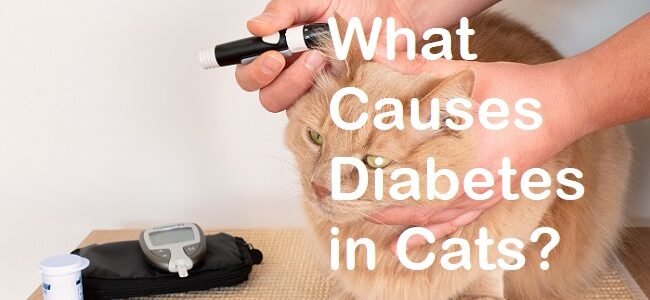The cells in a cat are similar to those in humans, and they require sugar in the form of energy. The glucose in the blood needs insulin to get access to cells. So, what causes diabetes in cats?
Diabetes Miletus in cats is a relatively widespread endocrine condition that is more common in aging cats. Diabetes is estimated to affect between 0.2 and 1% of cats during their lifetime.
The good news is that the condition is treatable and preventable. Let’s take a detailed look into what causes diabetes in cats.
How did my cat develop diabetes?
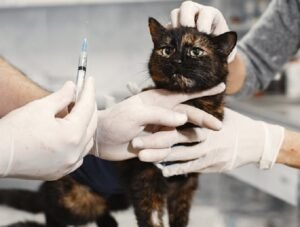
Diabetes is when the cat’s body cannot adequately produce or respond to insulin. The implication is that your cat would be unable to process glucose (blood sugar) effectively.
Insulin binds to cells and signifies the appropriate time to absorb glucose. As a result, cells receive vital fuel and reduce glucose levels in the blood by absorbing glucose.
Blood glucose levels are typically high in Type 1 diabetes due to decreased insulin production.
Similarly, glucose levels are also high in Type 2 diabetes because cells in the body do not respond adequately to insulin.
Cells in type 1 and 2 diabetes are unable to access the nutrients they require because insulin cannot transport sugar from the bloodstream into them.
However, type 2 diabetes is the most common form of diabetes that affects cats. Other common causes of diabetes in cats are:
- Obesity
- Chronic inflammation of the pancreas
- Destruction of pancreatic beta cells.
Cat Food Formulated for Diabetic Cats to Manage Glucose and Weight
| PRODUCT | FEATURES | CHECK PRICE | CHECK PRICE | |
|---|---|---|---|---|
 | Pro Plan Veterinary Dietary Wet Cat Food | High Protein Low Carb Specific for diabetes High Antioxidants Made in USA Vet authorization required 4.6 STARS |  | |
 | Purina Pro Plan Veterinary Diets Dietetic Management Dry Cat Food | Nutritionist and veterinary formulated Formulated for diabetic cats High protein Low carbs 4.7 STARS | ||
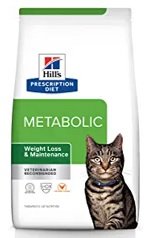 | Hill's Prescription Diet Metabolic Dry Cat Food | Veterinary formulated Vet authorization required Glucose support Weight management Low carbs High protein 4.8 STARS |  |
Note: Veterinarian approval required to order these products. For low carb, high protein cat food that does not require Veterinarian approval click HERE for reviews.
Diabetes risk factors in cats
Risk factors associated with diabetes:
- Age: Cats become more prone to diabetes as they increase in age
- Gender: Male cats are more likely to develop diabetes than their female counterparts.
- Obesity: Obese cats are four times more likely to develop diabetes than normal-weight cats.
- Breed: Burmese cats seems to have a higher risk of developing diabetes than any other breed.
- Physical activity: Lack of physical activity may also put your cat at risk of developing diabetes.
- Medications: Using glucocorticoids to treat other illnesses is a crucial risk factor for diabetes in cats.
Symptoms of diabetes in cats
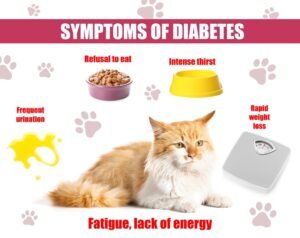
Diabetes in cats can be classified into two types. It includes the rare diabetes insipidus (DI) and the more prevalent diabetes Mellitus (DM).
Although they have similar symptoms, their primary causes are vastly different. The following are the clinical signs of diabetes in cats:
- Increased thirst and urination
- Weight loss regardless of a good appetite
- Lethargy
- Neurological symptoms include walking with the hooks of the hind legs on the floor
In Type 1 and Type 2 diabetes, the cells cannot absorb glucose from the blood and become energy starved.
The body shifts to other sources to get the energy required, breaking down fats and protein to feed glucose-starved cells. The result is weight loss despite an increase in appetite.
Similarly, excessive thirst and urination are also critical signs of diabetes in cats. In addition, high sugar levels can subdue the kidney’s ability to filter glucose, causing sugar to spill out from the blood and into the urine.
This high glucose concentration can attract excessive amounts of water into the urine. The result is increased urine volume, increased urinary water loss, dehydration, and an increase in thirst.
Diagnosing diabetes in cats
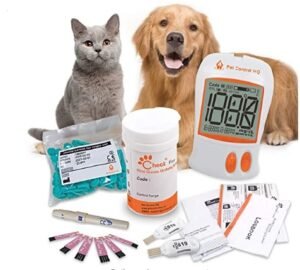
Your veterinarian will conduct several diagnostic tests to diagnose diabetes in cats. These tests are designed to measure your cat’s glucose level.
Other tests that help rule out other diseases and identify any other potentially related conditions can also be done. Some of these tests include:
- Blood glucose test
- Complete blood count
- Urinalysis
- Urine culture
- Abdominal radiographs
- Biochemistry profile
Generally, diagnosis of diabetes is performed if your cat has:
- High blood sugar (hyperglycemia)
- Sugar in urine (glycosuria)
- Weight loss despite good appetite
- Increased urination and thirst (polyuria)
- Polydipsia
High glucose levels in your cat’s blood could indicate diabetes. However, stress can temporarily raise your cat’s glucose level.
So you may have to repeat testing as soon as possible to confirm the diagnosis. A fructosamine test may be required o help differentiate between stress-caused glucose levels and diabetes in cats.
Your veterinarian may recommend other tests to help rule out other diseases contributing to your cat’s clinical signs. These tests may include a thyroid test to rule out hyperthyroidism, a urinary tract infection test, and a pancreatitis test.
Treatment of diabetes in cats
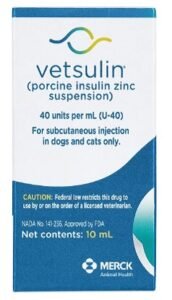
Treatment of diabetes in cats entails several measures. The main goal of diabetes treatment in cats is to;
- Restore normal blood glucose levels
- Halting or controlling weight loss
- Halting or reducing signs of increased thirst and urination
- Averting life-threatening low blood sugar levels due to treatment.
The main steps used in achieving these goals are insulin and dietary therapy.
Insulin Therapy
Injectable insulin has proven to be pretty effective in treating diabetes in cats. Insulin injections are usually given under the skin roughly every 12 hours.
Cat owners can learn how to administer insulin to their cats at home. However, feline lovers must ensure they use the appropriate syringe for their cat’s insulin, as each insulin type has its specific syringe.
Dietary Therapy
Studies have shown that food low in carbohydrates can help to improve blood sugar regulation in diabetic cats. Your veterinarian may recommend prescription food that comes in wet and dry forms and is beneficial for your cat.
Overweight cats with diabetes are monitored closely by a veterinarian for slow controlled weight loss to achieve better control over blood glucose concentrations.
Monitoring
Regular monitoring is a crucial part of treatment for cats with diabetes. In addition, periodic monitoring helps determine the suitable insulin dose for individual cats.
It also helps to avert complications that may arise, including hyperglycemia.
Remission
A cat can enter a state of diabetic remission with a comprehensive treatment plan. Remission occurs when the cat can maintain normal blood sugar levels without insulin injections.
Cats who have attained diabetic remission should continue to be fed a low carbohydrate diet and closely monitored.
Final Thoughts
Having a poor diet and obesity are common causes for diabetes in cats.
Although there is no cure for diabetic cats, the condition can be adequately managed with the correct regimen.
Insulin and dietary therapy coupled with close monitoring can help sufficiently control blood glucose levels in diabetic cats.

